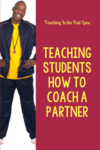
If you use a lot of cooperative learning strategies in your classroom you likely run into the dilemma of how to help students effectively coach one another.
I’ll set the scene:
You introduce a new cooperative learning strategy to your class that involves partners coaching one another. You release your students to get started and for the most part, it is going well, but you notice when it is time for students to coach their partner they are just giving them the answer.
Does this sound familiar?
In our classroom, this happened over and over again. Finally, I sat down with my students and explained in explicit detail what it looked like and sounded like to coach a partner.
What It Looks Like to Coach a Partner
When a student is coaching a partner their eyes should be on their partner’s work. This means that are probably in a huddle or leaning over their partner so they can get a good view of what they are doing. This is a tricky thing because you want to be close, but don’t want to crowd your partner.
The coach’s eyes should be focused and they should be ready to jump in at a moment’s notice if they are needed.
A coach is NOT looking around the room or talking with other students.
After talking about what it looks like to coach a partner we practice just this part. It takes students a few tries to find a happy medium to be close enough to their partner to see what is going on while still giving them their personal space. During this practice time, I take pictures to print out later and hang them around the room to serve as a visual reminder.

What It Sounds Like to Coach a Partner
We come back together to discuss what it sounds like to coach a partner. First I have students share out their ideas and then we make an example and non-example anchor chart together.
Coaching requires a lot of talking. We can all agree on that.
When you are coaching a partner I should hear you praising good work and making suggestions or answering your partner’s question.
What should NOT be heard is giving your partner an answer straight out. Instead, we practice a strategy called tip-tip-tell. Before a coach is able to give their partner an answer they much first give them two tips or suggestions. If their partner is still struggling then they walk them through the steps to answer, but still never just give the answer outright.
Encouraging Peer Coaching
Showing a student how to effectively coach a partner is a life skill that will take them far beyond the classroom because being able to help someone feel successful without doing the work for them is a vital part of life.
This process is one that will pay off throughout the year as you introduce new cooperative learning strategies that necessitate students working with one another.
Join the newsletter

Subscribe to our newsletter and receive this FREE 7 Continents Jigsaw cooperative learning activity and get started with cooperative learning strategies today!
